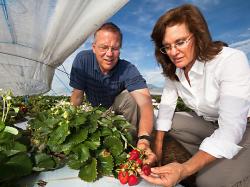Research Aims To Extend Strawberry Growing Season In Mid-Atlantic Region
October 25, 2012 | 1 min to read

Growing strawberry plants in the U.S. Mid-Atlantic region beneath canopy-like structures called low tunnels can allow the season to start earlier and continue through the summer and fall, according to U.S. Department of Agriculture (USDA) scientists.
At the Agricultural Research Service (ARS) Genetic Improvement of Fruits and Vegetables Laboratory in Beltsville, Md., geneticist Kim Lewers is testing some strawberry cultivars in the new production system designed to extend the growing season in the northern and eastern United States. Lewers' research partners are horticulturist John Enns and support services staffer George Meyers. ARS is USDA's chief intramural scientific research agency.
Low tunnels are canopies made of long sheets of plastic laid over support hoops that hold it about 30 inches above the strawberry bed. Strawberries are planted beneath these structures, which protect the fruit from rain, provide shade from damaging infrared and UV light, and can capture warmth during the cooler spring and fall seasons.
By protecting the plants from rain, the tunnels help to minimize two important diseases of strawberry, Botrytis and anthracnose, which thrive in the rain. Botrytis occurs in cool, wet conditions, while anthracnose takes hold in hot, wet conditions.
To read the rest of the story, please go to: ARS News Service
